1. History of the palace

Genuine Amber Room in the photo 1931
From the portrait of the hall you can go to the Amber Room - the pearl of the Catherine Palace, rightly called one of the wonders of the world.

The appearance of the Amber Room is fanned by legends and myths. Its purpose ascribed to the German architect and sculptor A. Schlüter (1664-1714), who was believed to have designed it for Littsenburga - the suburban residence of the Prussian Queen Sophia-Charlotte. Some authors have argued that the amber panels have not been installed in Berlin and passed as a gift to Russian Emperor Peter I incomplete, so it is not immediately able to collect them in St. Petersburg. Newly discovered documents make it possible to shed light on the history of the creation of this unique work of art.

Elector of Brandenburg, who owned Prussia - European center of amber craft - from 1618, using the "gold" of the Baltic Sea as has long been called amber, as a material for precious diplomatic gifts to other princes. This gave impetus to the rapid development of the art of amber processing, one of which was the vertex and the Amber Room.The period of its creation coincides with the flowering of the German general and, in particular, the Prussian art at the turn of the XVII and XVIII centuries.

Elector Frederick III (1657-1713), in 1701 crowned as the King of Prussia, Friedrich I, immediately after the accession to the throne took up the restructuring of its capital, and especially the royal residence - a complex of buildings XVI-XVII centuries.

Charlotte Sophia of Hanover
His wife, Queen Sophia Charlotte, before it hatched plans for belonging to her little summer palace Littsenburga, built in the years 1695-1699 JA Nehring and M. Grunberg. According to the hostess, he had become a sophisticated building with the park of Versailles facade pattern. In December 1701 the project presented by the architect I.-F.Eozanderom royal couple, was approved and became Master of the Queen's favorite architect.

Friedrich I - Elector of Brandenburg, under the name of Frederick III, 1688, the first king of Prussia, c 1701, a representative of the Hohenzollern dynasty.
Today we know that it is the author of the project Eozander Amber registration office for a long time is the creation of Schluter. Two favorite palace of King of Prussia, which is related to the fate of the Amber Room - Littsenburg (from 1709 - Charlottenburg) and Oranienburg - steel since 1707, after the departure from the post of Schluter palace architect, exclusive sphere of activity Eozandera.
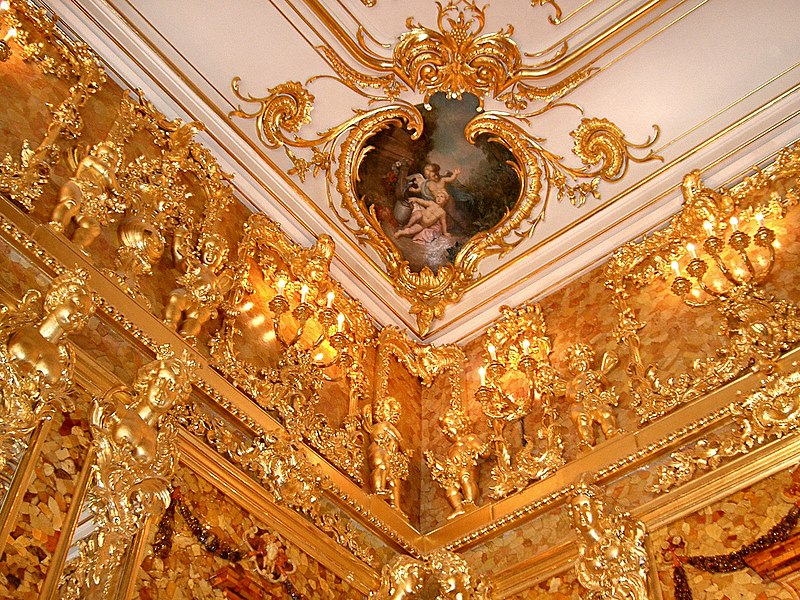
Initially the room with amber panels intended for Littsenburg Palace - the private residence of the Queen; to think of it, it appears to be the royal couple's visit has pushed not only on the occasion of the coronation of Frederick I in Königsberg - the capital of amber craft, but presenting him then gift - two large amber frames.
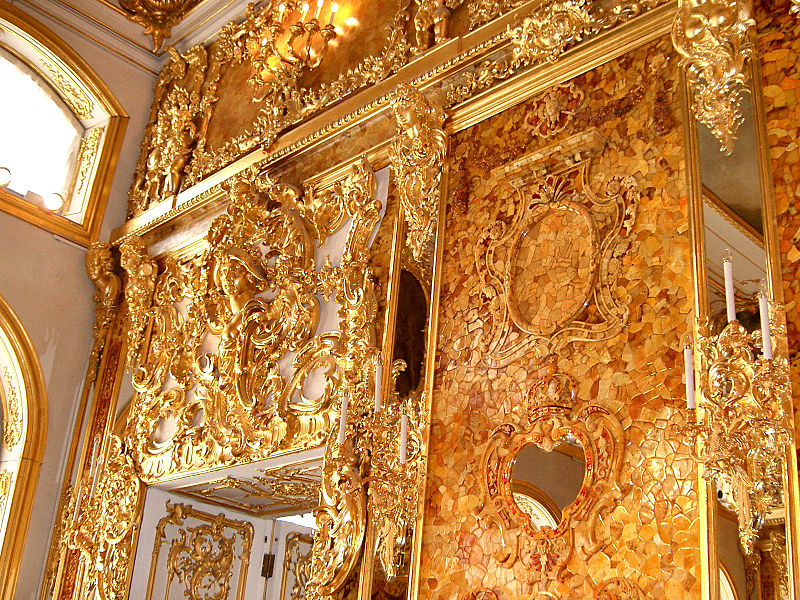
Perhaps the idea was born to Sophia-Charlotte, has a wide knowledge, varied interests, a deep passion for art and music. Amber Project office certainly had to perform her favorite architect Eozander who supervised all the works to expand Littsenburgskogo Palace.

Littsenburgsky Palace (now Charlottenburg)
For an ambitious idea in September 1701 was invited to Copenhagen carver amber and ivory G. Wolfram. However, in the summer of 1706 between it and Eozanderom conflict broke out: According to the court architect, Wolfram worked too slowly and not adhered to the approved project. Dane replaced the master of Danzig (now Gdansk) E. Schacht and Turaev, began work on the amber panels in 1707 and within six years of work on a unique finish.

In 1709, when the Sofia-Charlotte died, the Amber Room has not yet been completed, but Frederick I stopped working and decided to decorate the gallery amber panels in another palace - Oranienburg. Apparently, the King stopped construction in Littsenburge to keep the palace as it was during the life of his wife.
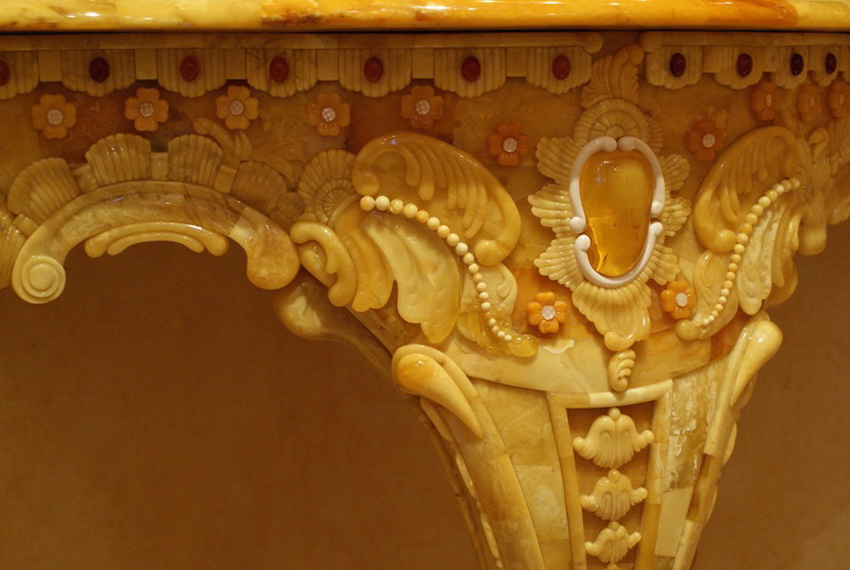
The walls are destined for amber panels, decorated with gold lace and damask; Red damastovuyu room can be seen in the palace today. It was since then in memory of Sophia Charlotte Littsenburg was called Charlottenburg.
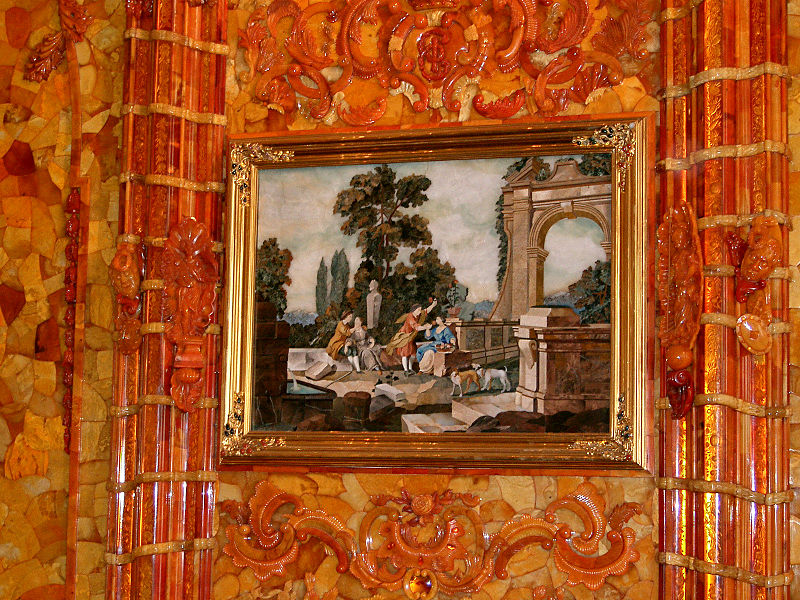
Meanwhile, the king instructed Eozanderu expansion Palace in Oranienburg with the device Amber gallery, exceeding the size of the previous project (30 meters). Inventory list Oranienburgskogo palace for 1743 contains specific information about the planned appearance of the gallery and discovered by German researchers figure the 1700s portrays her part in the decoration of which are recognized by many of the elements of the future of the Amber Room. However, despite the ongoing work, the gallery was not completed until the death of Frederick I (1713), and in Oranienburg amber panels were also installed.

During the life of Frederick I finished panel to the Amber Gallery inspected during one of his visits to Berlin (in 1712 or 1713) by Peter I. The Russian Emperor did not hide his admiration and desire to have such a unique creation at home.

Heir to the first Prussian King Friedrich Wilhelm I (1688-1740, reigned from 1713), went down in history as "the sergeant-major on the throne", he introduced strict discipline that focuses on the practical use, and stopped all the expensive work in the palaces of his father. However, the admiration of visitors, who saw the amber panels, prompting him after the accession to the throne to mount them in one of the offices of state rooms in the Berlin Royal Castle. This is the last and only accurately confirmed episode of stay amber miracle in Berlin to send to St. Petersburg. Neither in Charlottenburg or in Oranienburg panel has not been established, although in each of the palaces, a special room was set aside for them.

Friedrich Wilhelm I - King of Prussia, the Elector of Brandenburg, c 1713, of the Hohenzollern dynasty. It is known as the "King of Soldiers" father of Frederick the Great.
Frederick William I prepodnёs office to Peter I as a gift. Peter appreciated gift: "The King gave me a fair Prezent yahtoyu that Potsdam exceedingly clean, and the Cabinet of Amber, what has long wanted to" - he wrote to his wife Catherine. Amber Cabinet packed with great caution flown to St. Petersburg in 1717.

At a meeting with Peter I Frederick William I in November 1716 in connection with the conclusion of the alliance between Russia and Prussia, the Prussian king gave the Russian Emperor gifts, among which was the Amber Room.Peter I wrote at the time of the Empress Catherine: "It (Orolo) gave me a fair Prezent yahtoyu that Potsdam exceedingly clean, and the Cabinet of Amber, had long wanted." Two years later the Russian emperor sent Frederick William reciprocal gift - 55 Grenadiers gigantic growth and by his own cup of ivory.

According to preserved inventories, exploded Amber Study was delivered to St. Petersburg via the Memel and Riga in 18 large and small boxes, containing, along with ready-made panels of a large number of previously unused fragments. The documents were attached instructions regarding the manner in which should unpack amber jewelry before installation.

July 2, 1717 AD Menshikov looked delivered and unpacked in a panel at the Summer Palace, according to the instructions and informed the king about their condition: "The Cabinet of amber Your Majesty the King of Prussia, I presented revised and put in boxes of those in whom brought in a large chamber where guests gather, where much little or almost not enough to spoil. Some little things povypadali, but w seal, and even used the other was not, it can be re-set. True to say that most curiosity, which the world has not seen this. "

Since there is no evidence as to where Peter I ordered to establish a panel and ordered it at all, all the assumptions about their use in the Winter Palace groundless. It has been documented that his daughter, Empress Elizabeth, shortly after the accession to the throne has been applied precious gifts from Berlin to build for her a new winter residence - the Third Winter Palace, where in 1743, and was ordered to place the amber piece.

For repairing and correcting amber pieces invited Italian master A. Martelli. However, the prefabricated elements to decorate the new interior is not enough, so the architect Francesco Bartolomeo Rastrelli decided to put it mirrored pilasters and paint "under the amber" additional panels. In 1745, Frederick II gave Elizabeth one more amber frame, performed by A. Reich, in a decor which used allegories glorifying Russian empress.
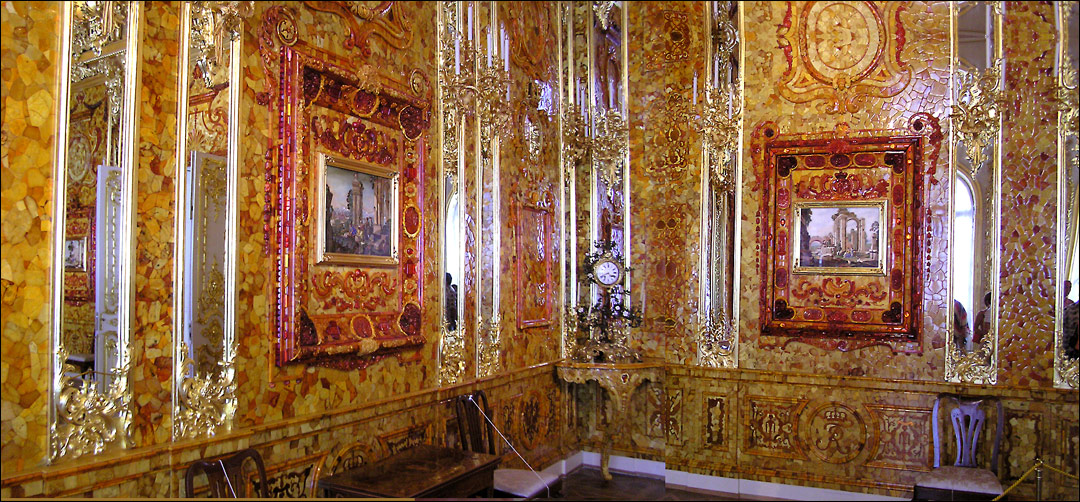
Collected in 1746. The Amber Room began to serve for official receptions, but as the reconstruction of the Winter Palace it is not just transferred from place to place.

In July 1755 Elizabeth ordered Rastrelli create new Amber Room in the Great Palace of Tsarskoye Selo. Head of the Office of the Cabinet of the Imperial Fermor instructed carefully disassemble the panel at the Winter Palace and put them in boxes. From Tsarskoye Selo was sent a special team, which is manually shifted boxes from the capital to the country residence. Thus began a new, almost two hundred year era of glory "the eighth wonder of the world" in Russia - his second home.
Reserved for the Amber Room Hall of the Grand Palace at Tsarskoye Selo area of 96 square meters is much higher than its previous size. Rastrelli placed symmetrically panel, in the middle tier of three walls, separated by pilasters adorned with mirrors and gilded room with wooden carvings. To install the panels on the walls of the newly invited Martelli wizard. Where not enough amber, fragments of walls were covered with canvas and painted "by Amber" artist Ivan Belsky.

Given the fragility of the material, special superintendent has been allocated for the room, which is constantly performing small restoration works. In 1758, for the position of Prussia was invited F. Roggenbuck, who led the work on the creation of new amber pieces in the workshop of Tsarskoye Selo.

In 1763, Empress Catherine II issued a decree replacing the painted canvases and manufacture of amber panels for the walls of the lower tier. However Roggenbuck the work begun by his son Johann, as well as previously invited to Russia K. and G. Fried, I. Velpendorf and Russian students. At this time, eight flat panels of the lower tier was made with Key figure, eight panels by pilasters and OVERDOOR to the middle door and carved details of the cornice, which include fragments of the Berlin operation. On these panels it took 450 kilograms of amber in four years, and in 1770 the creation of the Amber Room has been completed. The room has got its final form.
Amber piece, occupying three walls, was located in three tiers. The central (middle) tier made up of eight large vertical panels. The four of them set the composition of colored stones, executed in the 1750s in Florence in the Florentine mosaic technique based on sketches and D. Dzokki depicting allegories of the five senses: sight, taste, hearing, touch and smell. In between are high mirrored pilasters. Rectangular amber panels were placed in the lower tier of the room. In the northeast corner put small amber table on gracefully curved legs.

Additional decoration of the room made inlaid chests Russian and Chinese porcelain work. Here, in glass cases, it kept one of the most important European collections of amber products XVII-XVIII centuries the work of German, Polish and Russian masters.
As sudden changes in temperature, furnace heating, and drafts destroyed amber, only three times in the XIX century was carried out restoration of the Amber Room: in 1833, 1865, 1893-1897 years. Later, in the years 1933-1935, little restoration work was carried out by the sculptor I. Krestovsky. In 1941 it was scheduled a major restoration of the monument.
The surviving fragments of the original Amber Room (the Hermitage collection):

Casket. Danzig. The end of the 18th century. Amber, a metal foil; thread. The State Hermitage Museum. It was presented by Friedrich Wilhelm I to Peter the Great during his stay in Berlin in 1716.

Mirror. Konigsberg. 1700-1705. The State Hermitage Museum. At the Amber Room was presented to Friedrich Wilhelm I to Peter the Great during his stay in Berlin in 1716.

Mosaic picture "touch and smell." Italy, 1751. Entrance to the cycle of mosaics donated by Elizabeth Empress Maria Theresia

Most amber frame with Florentine mosaic "Taste". Ltd. "Tsarskoye Selo Amber Workshop", St. Petersburg, 2008. Repetition lost mosaic of the Amber Room.
The disappearance of the Amber Room

In the early days of World War II in the Catherine Palace, the evacuation of the museum treasures; Because of the fragility of amber panels it had decided not to dismantle them and make conservation in situ: panels pasted paper, then gauze, cotton besieged and closed wooden shields.
When Pushkin broke the German part, including experts' Kunstkomission "team, which was engaged in the export of art treasures, amber panels were removed and sent to Konigsberg. The book donation Koenigsberg Museum under number 200 kept a record of the Amber Room presented to the museum by the German state-controlled palaces and gardens.

The stolen amber panels carved and gilded doors were put up in one of the halls of Konigsberg castle, where the amber museum was. Its director, Rode in 1944 wrote that the Amber Room, returning to their homeland, the best decoration of Konigsberg. It was the last place on display a unique finish. In 1944, during the retreat of the Germans, the panel was again dismantled, packed into boxes and taken to an unknown destination. Since that time, the traces of the Amber Room lost. Her search is to no avail.

At the beginning of the Great Patriotic War museum values of the Catherine Palace were evacuated to Novosibirsk.Amber Chamber decided not to touch because of its fragility, made its preservation in place (this is the official version, since then the Germans dismantled the panels in just two days). Panels plastered paper first, then the gauze and cotton wool to protect from the blast. By capturing and robbing the Catherine Palace, the Germans were kidnapped and the Amber Room.
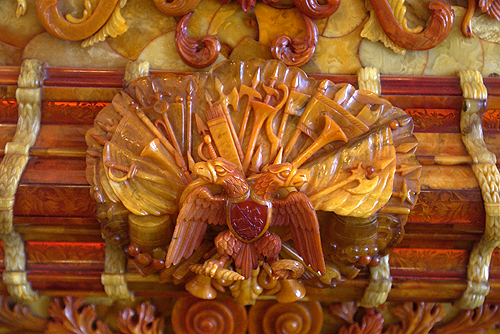

From 1942 to the spring of 1944 the Amber Room panels were installed in one of the halls of the Royal Castle of Konigsberg, which size was significantly smaller than the room in the Tsar's palace. Thus, since some of the amber panels became stored separately.


In August 1944, resulting in a massive raid British aviation was a fire here, but it is believed that the panel thus hardly affected, amber panels packed in boxes and lay down (according to witnesses) in one of the halls of the castle. Boxes with the panels were stored there until the beginning of the assault on the city by Soviet troops. The castle was occupied by the Soviet Army, April 9, 1945, and April 11 (as was clarified after many years) began an unexpected fire.

German officer who participated in the removal of the Amber Room in Tsarskoye Selo and illegally uvezshy part of her home as "souvenir" (this Florentine mosaic "The sense of smell and touch," one of the four made in 1787 by order of Catherine II), passed it on temporary storage of certain notariusu.Vposledstvii the notary tried to sell this mosaic, but in 1997 the German authorities confiscated her, he himself was tried and ownership mosaics recognized for his daughter. She refused the claims on the amber panels, transfer all rights to it the city Bremen, who gave it to the museum-reserve "Tsarskoye Selo".

